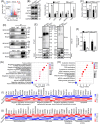DCAF2 regulates the proliferation and differentiation of mouse progenitor spermatogonia by targeting p21 and thymine DNA glycosylase
- PMID: 38837535
- PMCID: PMC11471390
- DOI: 10.1111/cpr.13676
DCAF2 regulates the proliferation and differentiation of mouse progenitor spermatogonia by targeting p21 and thymine DNA glycosylase
Abstract
DDB1-Cullin-4-associated factor-2 (DCAF2, also known as DTL or CDT2), a conserved substrate recognition protein of Cullin-RING E3 ligase 4 (CRL4), recognizes and degrades several substrate proteins during the S phase to maintain cell cycle progression and genome stability. Dcaf2 mainly expressed in germ cells of human and mouse. Our study found that Dcaf2 was expressed in mouse spermatogonia and spermatocyte. The depletion of Dcaf2 in germ cells by crossing Dcaf2fl/fl mice with stimulated by retinoic acid gene 8(Stra8)-Cre mice caused a reduction in progenitor spermatogonia and differentiating spermatogonia, eventually leading to the failure of meiosis initiation and male infertility. Further studies showed that depletion of Dcaf2 in germ cells caused abnormal accumulation of the substrate proteins, cyclin-dependent kinase inhibitor 1A (p21) and thymine DNA glycosylase (TDG), decreasing of cell proliferation, increasing of DNA damage and apoptosis. Overexpression of p21 or TDG attenuates proliferation and increases DNA damage and apoptosis in GC-1 cells, which is exacerbated by co-overexpression of p21 and TDG. The findings indicate that DCAF2 maintains the proliferation and differentiation of progenitor spermatogonia by targeting the substrate proteins p21 and TDG during the S phase.
© 2024 The Authors. Cell Proliferation published by Beijing Institute for Stem Cell and Regenerative Medicine and John Wiley & Sons Ltd.
Conflict of interest statement
The authors declare that they have no competing interests.
Figures








Similar articles
-
CRL4Cdt2 E3 ubiquitin ligase and proliferating cell nuclear antigen (PCNA) cooperate to degrade thymine DNA glycosylase in S phase.J Biol Chem. 2014 Aug 15;289(33):23056-23064. doi: 10.1074/jbc.M114.574210. Epub 2014 Jun 24. J Biol Chem. 2014. PMID: 24962565 Free PMC article.
-
Mice lacking DCAF2 in placenta die at the gastrulation stage.Cell Tissue Res. 2022 Sep;389(3):559-572. doi: 10.1007/s00441-022-03655-4. Epub 2022 Jun 17. Cell Tissue Res. 2022. PMID: 35711069
-
Ubiquitin E3 ligase CRL4(CDT2/DCAF2) as a potential chemotherapeutic target for ovarian surface epithelial cancer.J Biol Chem. 2013 Oct 11;288(41):29680-91. doi: 10.1074/jbc.M113.495069. Epub 2013 Aug 30. J Biol Chem. 2013. PMID: 23995842 Free PMC article.
-
MBD4 and TDG: multifaceted DNA glycosylases with ever expanding biological roles.Mutat Res. 2013 Mar-Apr;743-744:12-25. doi: 10.1016/j.mrfmmm.2012.11.001. Epub 2012 Nov 26. Mutat Res. 2013. PMID: 23195996 Free PMC article. Review.
-
The enigmatic thymine DNA glycosylase.DNA Repair (Amst). 2007 Apr 1;6(4):489-504. doi: 10.1016/j.dnarep.2006.10.013. Epub 2006 Nov 20. DNA Repair (Amst). 2007. PMID: 17116428 Review.
Cited by
-
DCAF13 is essential for mouse uterine function and fertility.Cell Death Discov. 2025 Aug 1;11(1):359. doi: 10.1038/s41420-025-02583-w. Cell Death Discov. 2025. PMID: 40750792 Free PMC article.
References
MeSH terms
Substances
Grants and funding
LinkOut - more resources
Full Text Sources
Molecular Biology Databases
Miscellaneous

